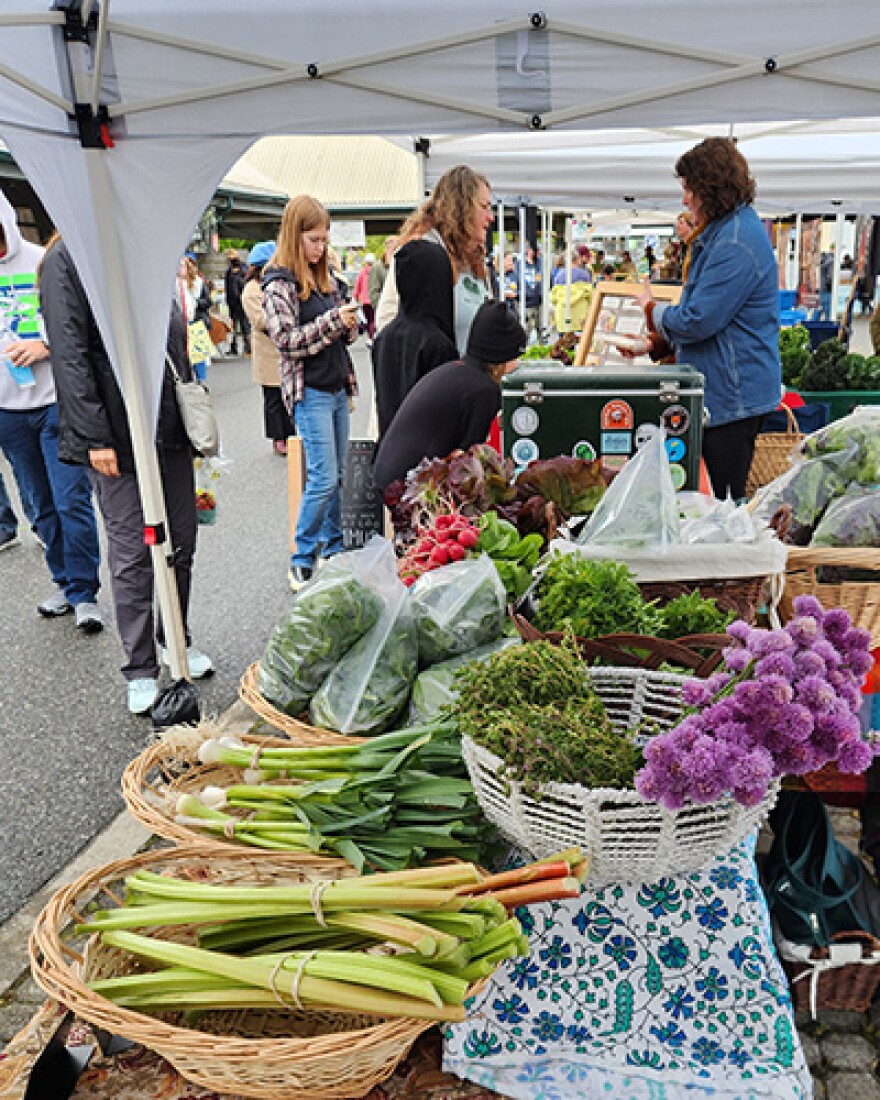“Food should be what brings people together. This is where you can do that,” said Arden Riseborough, about an hour into her first Bellingham Farmers Market as a vendor. This is her inaugural season selling her own food from Wild Mountain Farm, where she and her partner raise laying hens and grow many kinds of vegetables on “the cusp of Deming.”
Farmers markets provide new farms like Riseborough’s a chance to incubate their businesses, building connections and a sense of community that helps sustain them.

This is part of the market’s mission, said Chloe Knox, the new market director for the Bellingham Farmers Market, who started in March.
But that is not the only support farmers markets provide. Many customers need help, too. Fresh local produce, often organically grown with labor-intensive methods, is not cheap to grow or to buy. Farmers markets also fight food insecurity with several food access programs that provide fresh, locally grown food at a savings.
Low-income shoppers benefit — and so do farmers. Farmers markets in Northwest Washington bring these parties together in a festive atmosphere. (“Connecting Skagit’s food producers and food needs,” Salish Current, Jan. 15, 2024)
The mission of the Mount Vernon Farmers Market, said executive director Tia Entrikin, is to provide an outlet for local farmers and artisans to share their talents while also bringing together the community and educating.
All of that happens outdoors in vibrant downtown settings.
“You get all types of scenery and weather conditions and things that make it fun,” said Entrikin, as gray clouds and wind threatened.
Activities for kids and busking — jugglers and balloon artists, singers and musicians — feed the community energy and mark farmers markets as distinct from the grocery store experience
The season is on
The clock tower in Sedro-Woolley’s Hammer Heritage Square watched over more than a dozen vendors at the season’s first farmers market on May 22. It will do so every Wednesday until mid-October.
Vendors and shoppers were serenaded on opening day by Cascade Cody, a Northwest folk singer. He started his set with “Skagit Valley Forever,” a Malvina Reynolds classic from 1970 during the High Ross Dam controversy, extolling the natural virtues of the region and warning of its exploitation.
Community members milled around tents where vendors sold vegetables, mushrooms, plants, honey and more. They greeted friends with hugs and took time to learn about products.
Scenes like this are common at farmers markets around Northwest Washington.
Many farmers markets operate in Northwest Washington. The Washington State Farmers Market Association (WSFMA) has developed a set of guidelines designed to ensure the markets operate with consistent practices. Ten farmers markets operate in San Juan, Skagit and Whatcom counties under the WSFMA aegis.
One key requirement ensures that the majority of sales are farm-based. This ensures the markets primarily support local farms. WSFMA requires farms to be owned or leased in Washington (with a list of border counties also allowed). Any processed product, such as baked goods or berry jams, must be processed in Washington, too.

Those requirements help make farmers markets good retail outlets for farms like Mountain Song Meadows, which sells its produce at the Sedro-Woolley farmers market.
The farm is in a “beautiful, special place” in Marblemount, said Julie Jane “JJ” Weaver. Her husband, Noah, grew up on the property where the Weavers have been growing food for the last year and a half. “Life is encouraging us to do this,” JJ Weaver said; as people of faith, she explained, they feel called to this direction and have received blessings in their work.
“We just wanted to live a wholesome life,” said Weaver, and the family sees growing food as important work. And, it helps revive and pass on a skill set to their son, Moses.
While selling mixed salad greens and radishes, grown with organic methods and harvested that morning, Weaver explained that food insecurity is high in Marblemount. She wants to help improve that situation.
Weaver thinks that investing in healthy choices for food will carry over into other parts of peoples’ lives. In time, she hopes Marblemount could support its own market to get more healthy food into her community. For now, Mountain Song Meadows offers occasional pop-up opportunities there.
Helping with food access
Established markets like that in Sedro-Woolley offers some advantages compared to informal pop-ups, for those experiencing food insecurity.
Like most other markets in the region, Sedro-Woolley’s takes advantage of several food access programs.
Anyone who qualifies for SNAP (Supplemental Nutrition Assistance Program) can use their benefits at most of these markets. Many of them also participate in the state’s Market Match program, too, where the beneficiaries can match their benefits, which, for example, allows them $50 of fresh fruit and vegetables for $25.
At some markets, such as Mount Vernon, the match is limited to $25. But others have found additional funding with to extend the match for an unlimited amount.
The Farmers Market Nutrition Program is also available to participants in the Women, Infants, and Children (WIC) and low-income senior programs at local markets. SUN Bucks is another federal program that can be used in regional markets to supplement schoolchildren’s summer meals.
Other specialty programs include the Skagit Fruit and Veggie Prescription Program (FVRx), supported by United General, a health-focused community organization. FVRx provides vouchers for fruits and vegetables.
At the conclusion of a farmers market, volunteers glean unsold food and direct it to local food banks. (“Strengthening local food ties in COVID’s wake,” Salish Current, Jan. 31, 2024).
The Sedro-Woolley market donated nearly 1,000 pounds of food during the last season, while Bellingham farmers market vendors donated 10,000 pounds of fresh produce.

Combined, these food access and relief efforts help fight food insecurity, although not everyone knows about such programs. And supporting customers means more income for farmers as well.
Weaver estimated that up to 50% of her customers use the benefits at the Sedro-Woolley market. The proportion at other markets is not so high but the volume can be.
Two vendors at the Bellingham market characterized their customers’ use of benefits as “not much” or only about 10% to 15% of customers, although they noted participation was much higher at other markets they go to further south in Everett and Seattle.
Still the Bellingham market does a lot of these transactions. In 2023, it redeemed more than $61,000 in SNAP benefits and more than $53,000 in the Market Match. At the smaller Mount Vernon market, the Market Match last year was about $8,000, a sizable part of the $25,000 worth of free fruits and vegetables the market directed through its food access programs.
Building businesses, community and connections
“We like to connect to our customers,” said Belén Cabrera of Cabrera Farms in Burlington, part of Viva Farms.
When her uncle Miguel, who typically staffs the Bellingham farmers market, is gone, customers ask about him. This kind of familiarity builds community.
That is a large part of what the Cabrera family is doing at the market. “We want to offer produce to local people,” said Cabrera.
Regional farmers’ markets made that possible. She said 90% of the farm’s revenue comes from farmers markets with the rest provided by wholesalers like the Puget Sound Food Hub or restaurants.
Even when wholesale is a key part of a farm’s business plan, those connections can come through farmers markets.
Most, if not all of Everson’s Mariposa Farm‘s business comes through farmers markets, said Ruby Adkins, who works at the farm, staffs the Bellingham farmers market and manages the farm’s community-supported agriculture (CSA) program.

In 2021, a flood put Mariposa Farm beneath four feet of water. Community members rallied with more than $70,000 in support through a GoFundMe campaign. Adkins attributes that support to the social aspect and community building that happens at markets.
So does education.
Farmers markets provide a way to share a farm’s mission through direct conversation with customers.
“You can’t do that in a supermarket,” said Riseborough.
Those conversations are important for more than simple business reasons.
They allow Riseborough to answer questions about the different colored eggs her heritage-breed hens lay and to teach about their no-till, no-spray, small-acreage farm. The main goal of for Wild Mountain Farm is to grow “food that isn’t impacting the environment.”
The 2024 season is still early and not all the vendor spots are occupied yet. Soon, people selling plant starts will trade their spots for those selling fresh berries. Warmer, drier weather will bring out greater crowds, too.
No two markets or weeks are alike. As the seasons progresses, new produce will appear, some of which may be unfamiliar. But because it is fresh and local, the person staffing the market can tell shoppers all about it.
Riseborough said her first market was “amazing” and gave her “a little bit of a rush.” She appreciated the sales and many compliments her food attracted. They showed her that “what we’re doing is paying off.”
The multiple functions of farmers markets are paying off, too, with stronger farms, better-fed people and deepening community bonds.
The Salish Current is a nonpartisan, nonprofit, online local news organization serving Whatcom, San Juan and Skagit counties. We report local news with independence and strict journalistic integrity, providing fact-based information and a forum for civil commentary.






